|

| Swings |
Swings are something that kids come back to year after year. First it’s all about learning to just sit in a swing, then learning to pump, then there’s the sheer joy of swinging, followed by the years of tricks and amazing dismounts. When I was a kid, my sister and I would lollygag in the swings and talk over things that happened at school that day. Or I’d swing really high for 10 minutes to get over being mad at my mother. The way I see it, swings are essential.
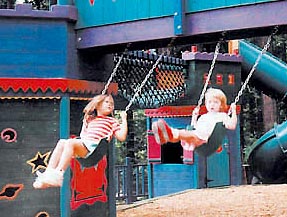
Belt Swing
The Belt Swing is a great modern invention. It isn’t heavy like the old wooden board and kids won’t hurt their heads if they bump into the belt swing. Belt swings conform to the body, so the kids stay in the swing. The plastic swing seats really stand up to years of use and they come in blue, green, yellow or red.

Baby Swing
My favorite Baby Swing is the full bucket swing shown in this photo. Parents don’t have to worry about the baby falling out, even if another child is doing the pushing. The baby swing and the belt swing have clips at the top that allow adults to swap the swings as needed.
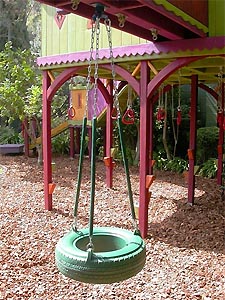
Tire Swing
My first Tire Swing was made from my own truck tire back in 1987. It wasn’t the best: the black rubber came off on the kids’ clothes, the attachments were clunky, water got trapped in the inside of the tire…I’ve learned a lot since then! Now I use a rotomolded plastic tire that is sturdy, lightweight, and doesn’t have any openings to collect water. I use a coated soft-grip chain which is easy on the kids’ hands and a heavy-duty lubricated tire swivel to hang the tire swing from the bridge beam. The result is fantastic: strong and fun for kids and adults.

Glider
Here’s a picture of me on my favorite Glider. Years ago I made a wooden glider that looked great but since it was made of wood, it was just too heavy. Then I found this molded plastic back-to-back glider. Kids have a blast with it: it’s lightweight, strong and fun. It requires a four-point mounting system. The glider works great in small spaces where you want to let a maximum number of kids enjoy swinging.

Rings
I like to add Rings to the underside of decks and bridges. Whether it’s two rings or twenty, kids enjoy finding and meeting the challenges the rings present. I mount the rings on a multi-rotational swivel to give them extra play. The length of chain can be reduced as the kids get older or the kids can alternate high and low rings to make the rings course more difficult.
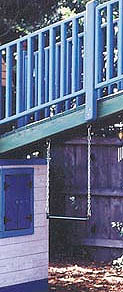
Hanging Trapeze Bar
You can also swap out a belt swing for a Hanging Trapeze Bar. It’s just another fun way to build in versatility to your play structure. Kids love hanging upside down by their knees or doing the "skin-the-cat" trick. There’s lots of games involving the trapeze bar.
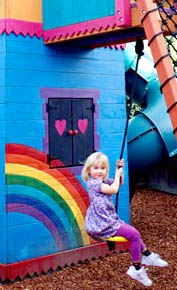
Disc Swing
The Disc Swing is a great way to add in a swing in a very small space. I mount it on a multi-rotational swivel so that it has different action than a belt swing. Kids can push off the fort with their feet and swirl around. There’s plenty of fun to be had with a disc swing!
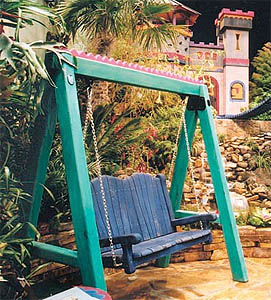
Swinging Bench
The Swinging Bench is probably more for Mom and Dad than the kids. Not only is it a comfortable bench but it’s nice to look at when empty. The swinging bench can hang under a bridge, or as shown in this photo, we made an A-Frame support.
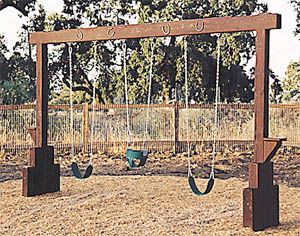
Freestanding Swings
Want a really big swing set that is sturdy enough to stand up to three adults swinging and still beautiful? I’ve made a variety of Freestanding Swings for numerous backyards. I really like this one because of the rustic, western look. It has three swings and two "perches" at either end for kids to hang out on while waiting their turn to swing. Since there’s not a bridge over top of the swings, the swing beam is higher, making for a bigger swing experience. It also requires more room: the higher the crossbeam, the greater the space required as a safety "use zone" in front and behind the swings.
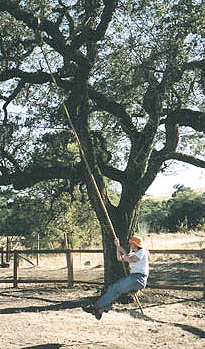
Giant Rope Swing
The Giant Rope Swing only works if you have a big, strong, healthy tree. Half of our work is finding the perfect branch. We climb up in the tree and test several spots, making sure it’s a good swing and that there’s enough space for swinging without banging into the tree trunk or a fence... Once we’ve tested the chosen branch, we attach the rope to the branch within a vinyl sleeve that protects the bark of the tree. At the bottom, we tie a strong yet comfortable knot to sit on.
|

|
 |
|
|